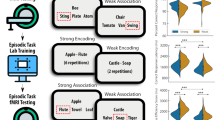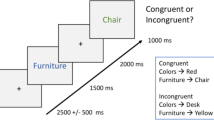Abstract
The relationship between episodic and semantic memory systems has long been debated. Some authors argue that episodic memory is contingent on semantic memory (Tulving 1984), while others postulate that both systems are independent since they can be selectively damaged (Squire 1987). The interaction between these memory systems is particularly important in the elderly, since the dissociation of episodic and semantic memory defects characterize different aging-related pathologies. Here, we investigated the interaction between semantic knowledge and episodic memory processes associated with faces in elderly subjects using an experimental paradigm where the semantic encoding of famous and unknown faces was compared to their episodic recognition. Results showed that the level of semantic awareness of items affected the recognition of those items in the episodic memory task. Event-related magnetic fields confirmed this interaction between episodic and semantic memory: ERFs related to the old/new effect during the episodic task were markedly different for famous and unknown faces. The old/new effect for famous faces involved sustained activities maximal over right temporal sensors, showing a spatio-temporal pattern partly similar to that found for famous versus unknown faces during the semantic task. By contrast, an old/new effect for unknown faces was observed on left parieto-occipital sensors. These findings suggest that the episodic memory for famous faces activated the retrieval of stored semantic information, whereas it was based on items’ perceptual features for unknown faces. Overall, our results show that semantic information interfered markedly with episodic memory processes and suggested that the neural substrates of these two memory systems overlap.





Similar content being viewed by others
References
Attali E, De Anna F, Dubois B, Dalla Barba G (2009) Confabulation in alzheimer’s disease: poor encoding and retrieval of over-learned information. Brain 132:204–212
Bentin S, Deouell L (2000) Structural encoding and identification in face processing: ERP evidence for separate mechanisms. Cogn Neuropsychol 17(1):35–55
Bentin S, McCarthy G, Wood C (1985) Event-related potentials, lexical decision and semantic priming. Electroencephalogr Clin Neurophysiol 60(4):343–355
Bernard F, Bullmore E, Graham K, Thompson S, Hodges J, Fletcher P (2004) The hippocampal region is involved in successful recognition of both remote and recent famous faces. Neuroimage 22(4):1704–1714
Boehm S, Paller K (2006) Do I know you? Insights into memory for faces from brain potentials. Clin EEG Neurosci 37(4):322–329
Cabeza R, Nyberg L (2000) Imaging cognition II: an empirical review of 275 pet and fMRI studies. J Cogn Neurosci 12(1):1–47
Chaby L, Narme P (2009) Processing facial identity and emotional expression in normal aging and neurodegenerative diseases. Psychologie et Neuropsychiatrie du Vieillissement 7:31–42
Cohen N (1981) Neuropsychological evidence for a distinction between procedural and declarative knowledge in human memory and amnesia. University of California San Diego
Craik FIM, Lockhart RS (1972) Levels of processing: a framework for memory research. J Verbal Learn Verbal Behav 11:671–684
Craik FIM, Tulving E (1975) Depth of processing and the retention of words in episodic memory. J Exp Psychol Gen 104:268–294
Curran T, Doyle J (2010) Picture superiority doubly dissociates the ERP correlates of recollection and familiarity. J Cog Neurosci 23(5):1247–1262
Dalla Barba G, Goldblum M (1996) The influence of semantic encoding on recognition memory in alzheimer’s disease. Neuropsychologia 34:1181–1186
Dalla Barba G, Frasson E, Mantovan MC, Gallo A, Denes G (1996) Semantic and episodic memory in aphasia. Neuropsychologia 34:361–367
Dalla Barba G, Parlato V, Jobert A, Samson Y, Pappata S (1998) Cortical networks implicated in semantic and episodic memory. Cortex 34:547–561
Denkova E, Botzung A, Manning L (2006) Neural correlates of remembering/knowing famous people: an event-related fMRI study. Neuropsychologia 44:2783–2791
Dobbins I, Schnyer D, Verfaellie M, Schacter D (2004) Cortical activity reductions during repetition priming can result from rapid response learning. Nature 428:316–319
Dobel C, Junghöfer M, Breitenstein C, Klauke B, Knecht S, Pantev C et al (2009) New names for known things: on the association of novel word forms with existing semantic information. J Cogn Neurosci 22:1251–1261
Donaldson DI, Rugg MD (1998) Recognition memory for new associations: electrophysiological evidence for the role of recollection. Neuropsychologia 36(5):377–395
Eimer M (2000) Event-related brain potentials distinguish processing stages involved in face perception and recognition. Clin Neurophysiol 111(4):694–705
Friedman D (2000) Event-related brain potential investigations of memory and aging. Biol Psychol 54(1–3):175–206
Friedman D, Johnson RJ (2000) Event-related potential (ERP) studies of memory encoding and retrieval: a selective review. Microsc Res Tech 51(1):6–28
Goldblum M-C, Gomez C-M, Dalla Barba G, Boller F, Deweer B, Hahn V et al (1998) The influence of semantic and perceptual encoding on recognition memory in alzheimer’s disease. Neuropsychologia 36(8):717–729
Greve A, van Rossun M, Donaldson D (2007) Investigating the functional interaction between semantic and episodic memory: convergent behavioural and electrophysiological evidence for the role of familiarity. Neuroimage 34:801–814
Halgren E, Dhond R, Christensen N, Van Petten C, Marinkovic K, Lewine J (2002) N400-like meg responses modulated by semantic context, word frequency, and lexical class in sentence. Neuroimage 17:1101–1116
Herzmann G, Sommer W (2010) Effects of previous experience and associated knowledge on retrieval processes of faces: an ERP investigation of newly learned faces. Brain Res 1356:54–72
Heun R, Freymann K, Erb M, Leube D, Jessen F, Kircher T et al (2007) Mild cognitive impairment (MCI) and actual retrieval performance affect cerebral activation in the elderly. Neurobiol Aging 28(3):404–413
Hodges J, Graham K (2001) Episodic memory: insights from semantic dementia. Philos Trans R Soc Lond B Biol Sci 356(1413):1423–1434
Hodges J, Patterson K (2007) Semantic dementia: a unique clinicopathological syndrome. Lancet Neurol 6(11):1004–1014
Jemel B, George N, Chaby L, Fiori N, Renault B (1999a) Differential processing of part-to-whole and part-to-part face priming: an ERP study. Neuroreport 10:1069–1075
Jemel B, George N, Olivares E, Fiori N, Renault B (1999b) Event-related potentials to structural familiar face incongruity processing. Psychophysiology 36:437–452
Joubert S, Brambati S, Ansado J, Barbeau E, Felician O, Didic M et al (2010) The cognitive and neural expression of semantic memory impairment in mild cognitive impairment and early alzheimer’s disease. Neuropsychologia 48(4):978–988
Kutas M, Hillyard S (1980) Reading between the lines: event-related brain potentials during natural sentence processing. Brain Lang 11(2):354–373
Lee D, Simos P, Sawrie S, Martin R, Knowlton R (2005) Dynamic brain activation patterns for face recognition: a magnetoencephalography study. Brain Topogr 18(1):19–26
Leveroni C, Seidenberg M, Mayer A, Mead L, Binder J, Rao S (2000) Neural systems underlying the recognition of familiar and newly learned faces. J Neurosci 20(2):878–886
Lounasmaa O, Hämäläinen M, Hari R, Salmelin R (1996) Information processing in the human brain: magnetoencephalographic approach. Proc Natl Acad Sci USA 93(17):8809–8815
MacKenzie G, Donaldson D (2009) Examining the neural basis of episodic memory: ERP evidence that faces are recollected differently from names. Neuropsychologia 47:2756–2765
Menon V, Boyett-Anderson J, Schatzberg A, Reiss A (2002) Relating semantic and episodic memory systems. Cogn Brain Res 13(2):261–265
Munte T, Brack M, Grootheer O, Wieringa B, Matzke M, Johannes S (1997) Event-related brain potentials to unfamiliars faces in explicit and implicit memory task. Neurosci Res 28:223–233
Nyhus E, Curran T (2009) Semantic and perceptual effects on recognition memory: evidence from ERP. Brain Res 4(1283):102–114
Osorio A, Ballesteros S, Fay S, Pouthas V (2009) The effect of age on word-stem cued recall: a behavioral and electrophysiological study. Brain Res 15:56–68
Paller K, Gonsalves B, Grabowecky M, Bozic V, Yamada S (2000) Electrophysiological correlates of recollecting faces of known and unknown individuals. Neuroimage 11(2):98–110
Rugg M, Curran T (2007) Event-related potentials and recognition memory. Trends Cogn Sci 11(6):251–257
Rugg M, Doyle M (1992) Event-related potentials and recognition memory for low and high-frequency words. J Cogn Neurosci 4:69–79
Schloerscheidt A, Rugg M (2004) The impact of change in stimulus format on the electrophysiological indices of recognition. Neuropsychologia 42:451–466
Snowden J, Thompson J, Neary D (2004) Knowledge of famous faces and names in semantic dementia. Brain 127:860–872
Sommer W, Komoss E, Schweinberger S (1997) Differential localization of brain systems subserving memory for names and faces in normal subjects with event-related potentials. Electroencephalogr Clin Neurophysiol 102(3):192–199
Squire L (1987) Memory and brain. Oxford University Press, New York
Squire L, Cohen N (1984) Human memory and amnesia. In: Lynch G, McGaugh JL, Weiberger NM (eds) Neurobiology of learning and memory. Guilford Press, New York
Staresina B, Bauern H, Deecke L, Walla P (2005) Magnetoencephalographic correlates of different levels in subjective recognition memory. Neuroimage 27(1):83–94
Tendolkar I, Rugg M, Fell J, Vogt H, Scholz M, Hinrichs H et al (2000) A magnetoencephalographic study of brain activity related to recognition memory in healthy young human subjects. Neurosci Lett 280(1):69–72
Trott C, Friedman D, Ritter W, Fabiani M (1997) Item and source memory: differential age effects revealed by event-related potentials. Neuroreport 8(15):3373–3378
Tulving E (1983) Elements of episodic memory. Oxford University Press, New York
Tulving E (1984) Multiple learning and memory systems. In: Lagerspetz KJ, Niemi P (eds) Psychology in the 1990’s. Elsevier, Holland
Tulving E (1985) How many memory systems are there? Am Psychol 40(4):385–398
Tulving E, Hayman G (1995) On the measurement of priming: what is the correct baseline? Eur J Cog Psychol 7(1):13–18
Walla P, Endl W, Lindinger G, Lalouschek W, Deecke L, Lang W (1999) Early occipito-parietal activity in a word recognition task: an EEG and MEG study. Clin Neurophysiol 110(8):1378–1387
Walla P, Hufnagl B, Lindinger G, Imhof H, Deecke L, Lang W (2001) Left temporal and temporoparietal brain activity depends on depth of word encoding: a magnetoencephalographic study in healthy young subjects. Neuroimage 13(3):402–409
Walla P, Püregger E, Lehrner J, Mayer D, Deecke L, Dal Bianco P (2005) Depth of word processing in alzheimer patients and normal controls: a magnetoencephalographic (MEG) study. J Neural Transm 112(5):713–730
Wilding E, Rugg M (1996) An event-related potential study of recognition memory with and without retrieval source. Brain 119:889–905
Zion-Golumbic E, Kutas M, Bentin S (2010) Neural dynamics associated with semantic and episodic memory for faces: evidence from multiple frequency bands. J Cogn Neurosci 22(2):263–277
Author information
Authors and Affiliations
Corresponding author
Rights and permissions
About this article
Cite this article
La Corte, V., Dalla Barba, G., Lemaréchal, JD. et al. Behavioural and Magnetoencephalographic Evidence for the Interaction Between Semantic and Episodic Memory in Healthy Elderly Subjects. Brain Topogr 25, 408–422 (2012). https://doi.org/10.1007/s10548-012-0222-5
Received:
Accepted:
Published:
Issue Date:
DOI: https://doi.org/10.1007/s10548-012-0222-5




